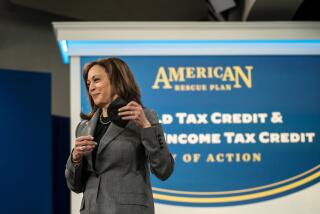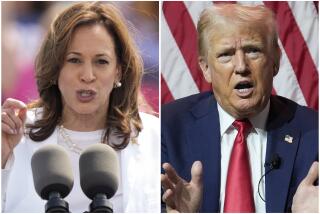Traditional Democratic Values Having a Rebirth : Economy: Burden falls to the wealthy in tax plan that takes from the rich and gives to the poor. Middle class will hardly be touched by new emphasis.
- Share via
WASHINGTON — President Clinton presented his budget plan as a historic shift in the government’s approach to economic policy and in some ways it is.
But when it comes to taxes, the budget Clinton fought so hard to push through Congress reflects the heart and soul of traditional Democratic values: take from the rich and give to the poor.
The bill would impose some $40 billion a year in new taxes on the 1% of American families with incomes over $200,000 and it gives billions in new tax breaks for low-income families. Most traditional of all, it allows the vast middle class to escape almost untouched, except for a 4.3-cent-per-gallon gasoline tax increase that would cost the average Californian $31 a year.
As a result, the plan represents a significant step toward reversing the basic economic and tax philosophy written into law more than a decade ago under Ronald Reagan. While Reagan sought to reduce the tax bite on the rich--arguing that if he did so they would invest more and spur economic growth--Clinton seeks to raise taxes on the wealthy and contends that doing so will promote a fairer division of the burden.
Yet, while the plan shifts tax policy to another course, most American families will scarcely notice a difference in their pocketbooks one way or the other. In the context of the overall national economy, this huge six-month debate has expended enormous energy to make relatively marginal changes.
Over the next five years, the government will raise and spend some $7 trillion. The new law would increase taxes by just under $241 billion over the period--a shift of 3.6%. Looked at in the overall context of the vast American economy, the tax increases amount to less than 1% of the nation’s total production over the five-year period.
When all is said and done--accounting for changes in all federal taxes, including income and excise taxes, Social Security taxes and corporate levies--the wealthiest Americans, that small group with family incomes over $200,000, will pick up a larger share of the burden of government and will give up a chunk of their total income--about 6.7%, according to government statistics--to do so. The poorest Americans, a much larger group with incomes below $10,000, will get some more money but not a lot.
And the middle class will pay almost nothing more, a message substantial numbers of Americans have missed. A recent poll conducted for the White House found that some 46% of Americans believe that the burden of new taxes will fall primarily on the middle class.
“Most of these people appear to be misinformed,” said Thomas Bloch, head of the H&R; Block tax firm. “Middle-income taxpayers and the vast majority of the elderly have emerged unscathed,” Bloch added in a statement issued by his firm.
The picture of who bears the burden of federal taxation--or, in economists’ phraseology, the “progressivity” of the tax system--would certainly change under Clinton’s plan. Once all the increases are put into place, the wealthiest 1% of American families will be paying more than 18% of total federal taxes, according to Administration tax estimates, which is a considerably higher share than they have paid in any recent year.
Whether that result will be good or bad for the economy depends, of course, on which economic theory one believes. To conservative, supply-side economists and the politicians, mostly Republicans, who follow their teachings, higher taxes merely discourage the wealthy from investing their money. With less investment will come less growth and with less growth, fewer jobs, they argue.
More liberal economists, such as those who predominate in the Clinton Administration, dismiss that argument. Wealthy people would stop investing if tax rates were confiscatory, they concede, but, they argue, the tax rates that would result from Clinton’s proposals are not higher than those the nation prospered under in the past and are considerably lower than those in many other major industrial nations.
The deficit cannot be narrowed without more revenue, they argue, and the fairest way to get that revenue is to raise taxes on the rich.
The two camps also disagree sharply on what has happened to the progressivity of the tax system in the last decade. Looking at the same data, conservative and liberal economists come up with very different interpretations.
As conservatives look at things, the share of federal taxes paid by the wealthiest Americans has actually grown in the last 12 years. In 1980, they note, the wealthiest 1% of American families paid 12.8% of all federal taxes, according to census figures compiled by the Congressional Budget Office. By 1990, that wealthiest group was paying 14.9% of all federal taxes, and that figure was projected to rise to 15.8% by 1994 even without the Clinton tax increases, which would take their share to the 18% level.
By contrast, the share of taxes paid by the entire poorest fifth of the population fell from 1.6% of the total in 1980 to 1.4% in 1990 and has continued to drop.
Liberal economists, however, argue that those figures are misleading. The reason the share of taxes paid by the wealthy has grown is that over the last decade, they have received more than a 50% boost in the share of national income they take.
The wealthy are paying more dollars in taxes because they have been getting more dollars in wealth, Administration economists and their allies argue. The proper way to look at the tax burden, they say, is to look at overall tax rates--the percentage of income paid in taxes.
In 1977, the richest 1% of Americans paid 35.4% of their income in federal taxes. By 1985, after the Reagan tax cuts had fully taken effect, the overall tax rate of the wealthy had plummeted to 24.5%.
Since then, however, a series of tax bills have taken back parts of the Reagan-era tax reductions, and by 1990, the tax rate of the wealthy had risen to 26.3%. Under Clinton’s proposed increases, the overall tax rate for those earning more than $200,000 will rise to 32.7%--not quite back to the 1977 level, but nearly so.
By contrast, the poorest fifth of American families--roughly speaking those with incomes below $20,000--currently pay an overall federal tax rate of about 8%. Under Clinton’s bill, their tax rate will fall another 1%, roughly speaking.
More to Read
Get the L.A. Times Politics newsletter
Deeply reported insights into legislation, politics and policy from Sacramento, Washington and beyond. In your inbox three times per week.
You may occasionally receive promotional content from the Los Angeles Times.











